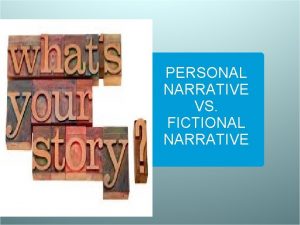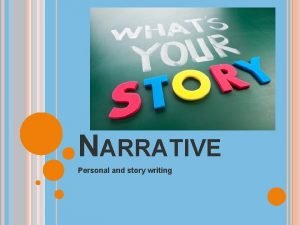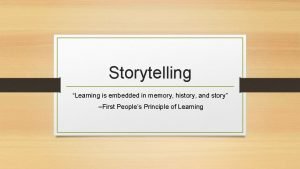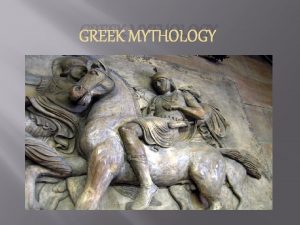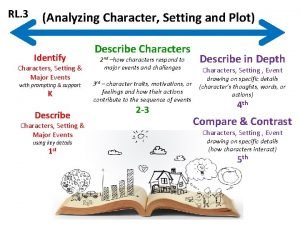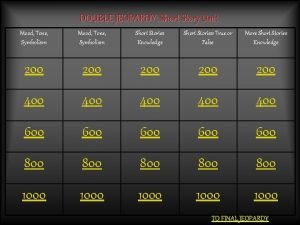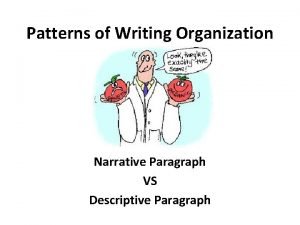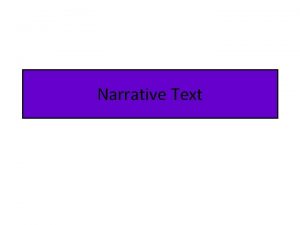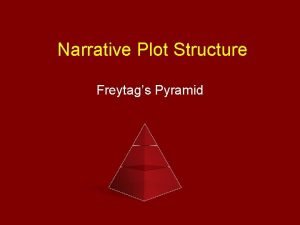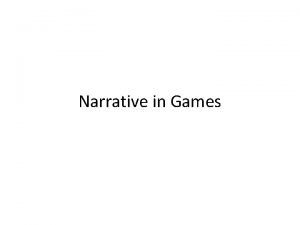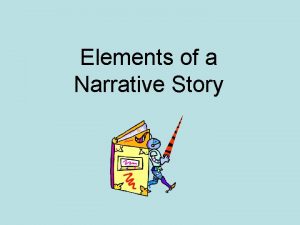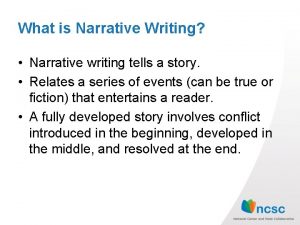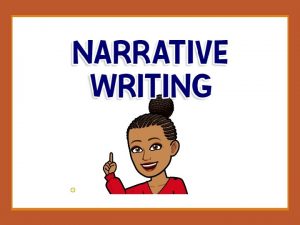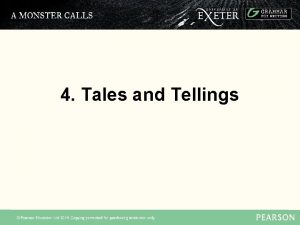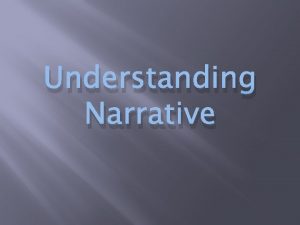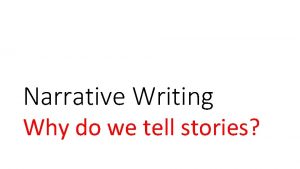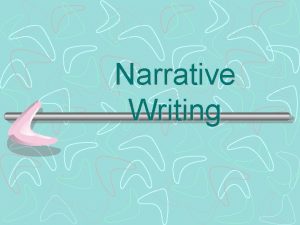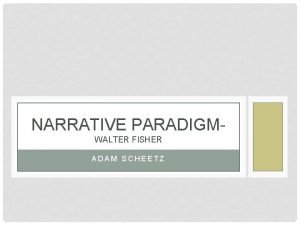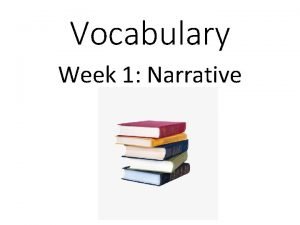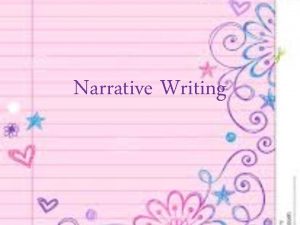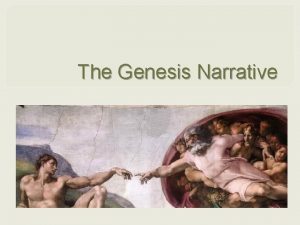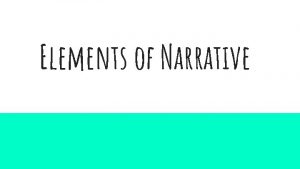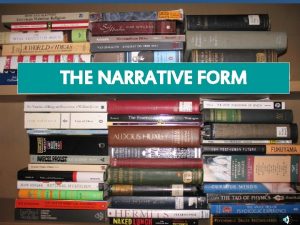Narrative in Story and History Narrative tellings stories













![“The first term [zero focalization] corresponds to what English-language criticism calls narrative with omniscient “The first term [zero focalization] corresponds to what English-language criticism calls narrative with omniscient](https://slidetodoc.com/presentation_image/802c2e989b38146bb0e28392872ba0e7/image-14.jpg)









- Slides: 23

Narrative in Story and History

Narrative tellings stories (true or false), factual or fictional, in any medium Narration process of telling stories, rather than product different ways to tell stories, jokes to adverts, comics to novels

actual writer ◄► 'external‘ narrator ◄► character as narrator ◄► narratee ◄► actual reader

actual writer historical person 'external' narrator image of how the writer projects him or herself character-as-narrator relates to and participates in action narratee addressee of narrative, person it appears to be directed at, ('dear reader') actual readers person who engages with narrative

writers define themselves through dialogue with narrators characters with 'external' narrator narration is a negotiation between these elements, not a thing points of view and centers of attention are never fixed reader tells a tale, but we play a part too, are a part of the text

Flatland: A Romance of Many Dimensions (1884), by A. Square (Edwin Abbott) I CALL our world Flatland, not because we call it so, but to make its nature clearer to you, my happy readers, who are privileged to live in Space. Imagine a vast sheet of paper on which straight Lines, Triangles, Squares, Pentagons, Hexagons, and other figures, instead of remaining fixed in their places, move freely about, on or in the surface, but without the power of rising above or sinking below it, very much like shadows - only hard and with luminous edges - and you will then have a pretty correct notion of my country and countrymen. Alas, a few years ago, I should have said "my universe": but now my mind has been opened to higher views of things.

In such a country, you will perceive at once that it is impossible that there should be anything of what you call a "solid" kind; but I dare say you will suppose that we could at least distinguish by sight the Triangles, Squares, and other figures, moving about as I have described them. On the contrary, we could see nothing of the kind, not at least so as to distinguish one figure from another. Nothing was visible, nor could be visible, to us, except Straight Lines; and the necessity of this I will speedily demonstrate. Place a penny on the middle of one of your tables in Space; and leaning over it, look down upon it. It will appear a circle.

But now, drawing back to the edge of the table, gradually lower your eye (thus bringing yourself more and more into the condition of the inhabitants of Flatland), and you will find the penny becoming more and more oval to your view; and at last when you have placed your eye exactly on the edge of the table (so that you are, as it were, actually a Flatlander) the penny will then have ceased to appear oval at all, and will have become, so far as you can see, a straight line.

Kazuo Ishiguro, Never Let Me Go (2005) My name is Kathy H. I'm thirty-one years old, and I've been a carer now for over eleven years. That sounds long enough, I know, but actually they want me to go on for another eight months, until the end of this year.

Structural aspects of narrative some formalist dichotomies: story/plot. Story - what is told, Plot - how it is told tell events from Bible or Blade Runner, but won't help how it was told Fabula/sjuzet. (Formalist) Fabula raw narrative events, dates, places etc. Sjuzet chronological sequencing and structural logic of telling. discours/skaz discours (French) and skaz (Russian) when teller is acknowledged (character as narrator). Distinct from historie/historia where narrator is invisible. In English: yarn, anecdote vs report, account

Types of narrative: first-person omniscient, partial omsiscient (remember focalization) reliable, unreliable Types of narrative episodes beginnings, middles and ends essential, optional kinetic, action static, description, state and atmosphere

Focalization- "introduced by Gerard Genette to distinguish the activity of the narrator recounting the events of the fictional world from the activity of the character from whose perspective events are perceived, or FOCALIZED. The distinction between the narrator and the FOCALIZER is commonly described in literary theory as a distinction between the agent 'who speaks' and the agent 'who sees. ' (Stam et al). Focalization is different from point of view in that it is focuses on the diegetic level of the text, to the level of characters and actions. . . Different types defined by Genette: Internal focalization - "occurs when a narrative is presented entirely from a given character's perspective, with the limitations and restrictions this implies" (ibid. ). Genette - "the angle of vision, from which the life or the action is looked at".

Also - Facets of focalization - Perceptual facet, psychological facet, ideological facet. Internal focalization can be fixed - limited to a single character, variable, when focalization shifts with a scene or film from one character to another, or multiple - one event is viewed from several different perspectives. Another type is EXTERNAL FOCALIZATION - "narratives in which our knowledge of the characters is restricted simply to their external actions and words, without the 'subjectivity' of the characters, their thoughts and feelings, being invoked. Problematic. Also, NONFOCALIZED or ZERO FOCALIZATION - no character is privileged. Also CHARACTER-FOCALIZER. (Stam et al).
![The first term zero focalization corresponds to what Englishlanguage criticism calls narrative with omniscient “The first term [zero focalization] corresponds to what English-language criticism calls narrative with omniscient](https://slidetodoc.com/presentation_image/802c2e989b38146bb0e28392872ba0e7/image-14.jpg)
“The first term [zero focalization] corresponds to what English-language criticism calls narrative with omniscient narrator and Pouillon ‘vision from behind, ’ and which Todorov symbolizes by the formula Narrator > Character (where the narrator knows more than the character, or more exactly, says more than any of the characters knows). In the second term [internal focalization], Narrator = Character (the narrator says only what a given character knows); this is narrative with ‘point of view’ after Lubbock, or with ‘restricted field’ after Blin; Pouillon calls it ‘vision with. ’ In the third term [external focalization], Narrator < Character (the narrator says less than the character knows); this is the ‘objective’ or ‘behaviorist’ narrative, what Pouillon calls ‘vision from without’” (Genette [1972] 1980: 188– 89).

Internal Focalization, Virginia Woolf, Mrs Dalloway And there the motor car stood, with drawn blinds, and upon them a curious pattern like a tree, Septimus thought, and this gradual drawing together of everything to one centre before his eyes, as if some horror had almost come to surface and was about to burst into flames, terrified him (Woolf 15).

Raymond Carver ‘The Bridle’ • The old station wagon with Minnesota plates pulls into a parking space in front of the window. There’s a man and woman in the front seat, two boys in the back. It’s July, temperature’s one hundred plus. These people looked whipped. There are clothes hanging inside; suitcases, boxes, and such piled in back. (external focalization) • From what Harley and I put together later, that’s all they had left after the bank in Minnesota took their house, their pickup, their tractor, the farm implements, and a few cows. (internal focalization)

Vladimir Propp, Morphology of the Folktale (1928) 31 narrative functions, stereotypical actions based on Russian folktales hero, helper, dispatcher, villain, princess function in predicable ways, fuction 25 --a difficult task is proposed to the hero function 26 -the false hero or villain is exposed function 31 --the hero is married and ascends the throne look at Superman, Star Wars, soap operas

Visualizing a text from a variety of perspectives and in a variety of dimensions foreground, what appears closes and most prominent to someone background, what appears remotest and most inconspicuous point of view, vantage point from which a particular even is seen, and by extension, heard, felt and otherwise perceived


Paul Garvin used term foregrounding as translation of Czech aktualisace, actualising, used in the 1930 s Prague school of stylistics this is whenver a linguistic item, device or strategy draws attention to itself against the assumed background norms of the language result if a fresh perception both of the event represetned and of the nature of language itself this is where defamiliarisation occurs. examples, in jokes whre the ambiguity or incongruity of an item draws attention to itself 'My dog smells awful, How does yours smell? (With its nose) also along with poetry, a heightening of sound-pattern can also omit commas, line breaks, etc. . . Also deviation is used o describe instances where the routine norms and expectations of the language are bent of broken, deliberately or accidentally e. e. cummings: anyone lived in a pretty how town problem is that it assumes we all have the same norms and expectations

I love you not I love you not I love you notwithstanding

She was standing by the door. The light went on. While she was standing by the door, the light went on. She was standing by the door when the light went on. The light went on. She was standing by the door!

Background 'historical background' 'background reading' somehow, people think, literature is detachable from social and historical conditions in which it is produced study the text, but what about the context, and intertextuality? however, foreground = literature = primary text background = society/history = context this is a position, and just one among many all works are witten, received and read in a history (ontic) but by practical necessity we must focus on something, choose make something the foreground, something background but be aware these are fluid
 Fictional narrative stories
Fictional narrative stories Difference between narrative and story
Difference between narrative and story Narrative vs story
Narrative vs story Learning is embedded in memory history and story
Learning is embedded in memory history and story Every picture has a story and every story has a moment
Every picture has a story and every story has a moment Story elements problem and solution
Story elements problem and solution What is apollo's realm
What is apollo's realm Describe a setting
Describe a setting Once upon a time lived a princess
Once upon a time lived a princess Gerund and infinitive story
Gerund and infinitive story Short story
Short story Mood short story
Mood short story Panos ipeirotis
Panos ipeirotis History also history physical
History also history physical What is narrative text ? *
What is narrative text ? * Nightmare story writing
Nightmare story writing Narrative elements
Narrative elements What is purpose of the narrative? *
What is purpose of the narrative? * Freytag plot pyramid
Freytag plot pyramid Narrative vs story
Narrative vs story Elements of a narrative story
Elements of a narrative story Narrative writing tells a story
Narrative writing tells a story Personal narrative story
Personal narrative story Narrative writing tells a story to
Narrative writing tells a story to
